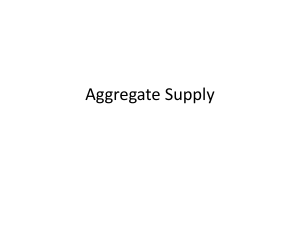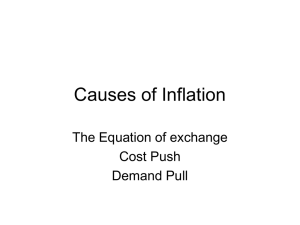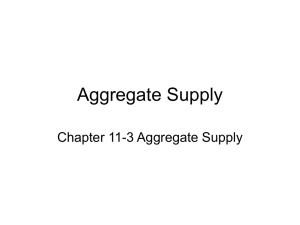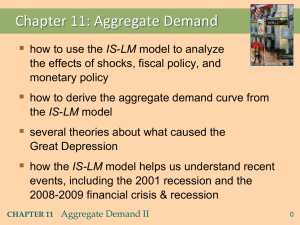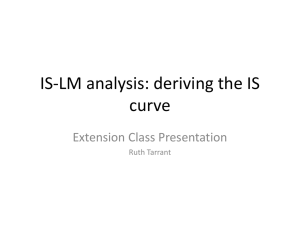Aggregate Demand
advertisement
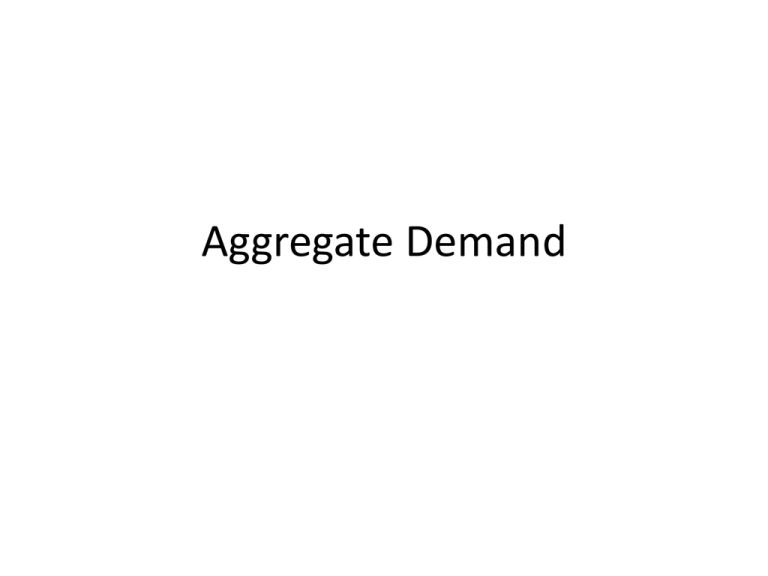
Aggregate Demand Aggregate Demand Aggregate Demand slopes downward like other demand curves, but for different reasons. Aggregate Demand • An increase in the aggregate price level will cause real spending to decrease. This is seen as a movement upward along a given AD curve • Because GDP = C+I+G+(X-M), anything that increases one of these components will shift AD to the right Aggregate Demand • The AD curve slopes downward, but it is not the usual law of Demand that explains this slope. • AD is a curve that shows the relationship between the aggregate price level and the quantity of aggregate output demanded by households, firms, the government, and the rest of the world. Why is the AD curve downward sloping? • Wealth or real balances effect – When price level falls, purchasing power of existing financial assets (like money in your savings account) rises, this can increase consumer spending and there is a downward movement along the fixed AD curve. • Interest-rate effect – – A decline in price level means lower interest rates which can increase levels of certain types of spending. How does this work? Why is the AD curve downward sloping? • A lower price level increases the purchasing power of money in your pocket so you need to hold less money to buy your goods and services. • This decrease in the demand for money holdings puts downward pressure in interest rates. • Remember – Nominal interest rate = real interest rate + expected inflation. If inflation expectations gradually fall, nominal interest rates should also gradually fall. • Lower interest rates will increase investment spending, thus increasing real GDP along the AD curve. Shifts of the Aggregate Demand Curve • There are shifts of the aggregate demand curve, changes in the quantity of goods and services demanded at any given price level. • An increase in Aggregate demand means a shift of the AD curve to the right. • A rightward shift occurs when the quantity of aggregate output demanded increases at any given aggregate price level. Shifts of the Aggregate Demand Curve • A decrease in aggregate demand means that the AD curve shifts to the left. • A leftward shift implies that the quantity of aggregate output demanded falls at any given aggregate price level. • Whether AD shifts to the right or to the left, the multiplier effect increases, or decreases, total spending throughout the economy Shifts of the Aggregate Demand Curve • Changes in Expectations: When consumers and firms are more optimistic about their future economic prospects, they will increase consumption and investment spending. – This shifts the AD to the right • Changes in Wealth – When the value of accumulated household assets goes up, consumers respond by increasing current consumption. This is one reason why a weak stock market or real estate market has a negative ripple effect in the economy – Shifting the AD to the left Shifts of the Aggregate Demand Curve • Size of the Existing Stock of Physical Capital: • Firms plan to invest in physical capital when the stock is being depleted or is insufficient to meet demand for their products – If firms have plenty of physical capital already, investment spending will slow down. Shifts of the Aggregate Demand Curve • Government Policies and Aggregate Demand: – Government can have a powerful influence on aggregate demand and that, in some circumstances, this influence can be used to improve economic performance • Two main ways the government can influence the aggregate demand are through fiscal policy and monetary policy Shifts of the Aggregate Demand Curve • Fiscal Policy – Congress and the President control fiscal policy. • Fiscal policy is the use of either government spending – government purchases of final goods and services and government transfers – or tax policy to stabilize the economy. • Suppose the economy was in a recession. The government can intervene directly or indirectly. Shifts of the Aggregate Demand Curve • If the government increases spending (G), it will have a direct impact on AD by shifting AD to the right. • If the government decreases taxes, this would increase disposable income, and this would increase consumption spending. • The increase in C would shift the AD curve to the right, helping to indirectly reverse the recession. Shifts of the Aggregate Demand Curve • Monetary Policy – The Federal Reserve controls monetary policy – the use of changes in the quantity of money or the interest rate to stabilize the economy. • When the Federal Reserve (the Fed) increases the quantity of money in circulation, households and firms have more money, which they are willing to lend out. • This drives the interest rate down at any given aggregate price level, leading to higher investment spending and higher consumer spending. • Thus increasing the quantity of money shifts the aggregate demand curve to the right.





